A large variety of trees and plants are currently adorning our planet and helping it sustain and bring more beauty to this world.
There’s a 99% chance you will see some greenery decorating the ground anywhere you go. Some can be so beautiful that you must stop and watch them!
Regrettably, many individuals often overlook the enchanting allure of willow trees simply because they aren’t familiar with them. We aim to rectify that oversight!
In this article, not only are we going to introduce you to willow trees, but we’re also going to list down the different types of willow trees that you may come across.
Read: 13 Most Common Types of Cherry Trees (With Pics)
13 Most Common Type of Willow Trees
Some of the common types include:
1. Purple Willow (Salix purpurea)
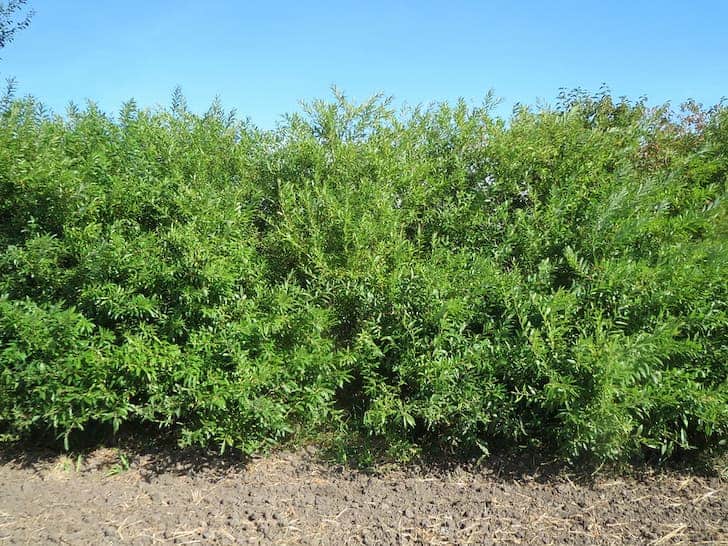
The purple willow, also known as the purple osier or the salix purpurea, belongs to the family of Salicaceae. This is a species of willow that is usually found native to the British Isles or Western Asia and most of Europe. They can also be found in Poland and the Baltic States.
The purple salix, or the purple willow, is a shrug consisting of purple stems and blue-green leaves. The primary purpose of this shrub is to control erosion alongside the streams and rivers.
Even the bark of the purple willow can bring you great benefits, such as treating arthritis, diarrhea, fever, headache, and other severe issues like the inflammatory stages of an auto-immune disease.
These shrubs are famous for making your garden look beautiful, especially since the purple willow is evergreen and has a high tolerance for cold and poor soils.
2. Weeping Willow (Salix babylonica)
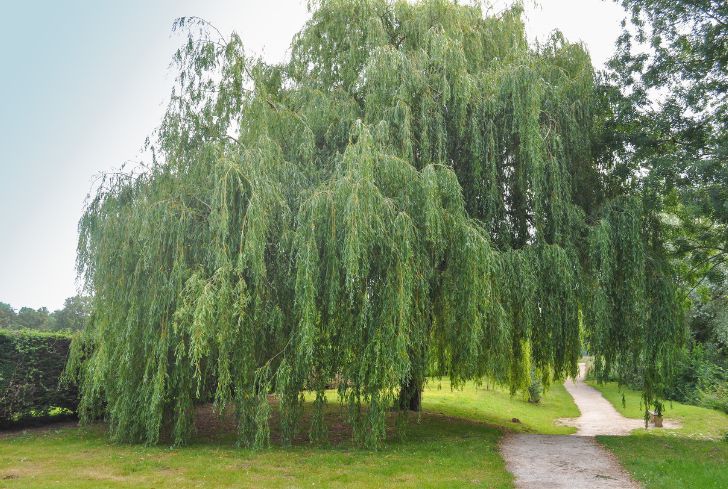
Associated with grief and mourning in many cultures, the weeping willow is also known as the Salix babylonica.
This species of the willow tree is known to be native to China and is planted in graveyards in many Asian countries to express the loss and mourning that people go through.
Although they look pretty, it is recommended to plant a weeping willow at least 50 feet from your home and preferably near a water body. The reason for this is that the babylonica is known to have aggressive roots that are invasive and can cause bumps to form in the ground.
The shallow roots of this tree allow the tree to topple over and create a round shape, with an open crown of branches that spread around 6-8 zones.
3. Bebb Willow (Salix bebbiana)
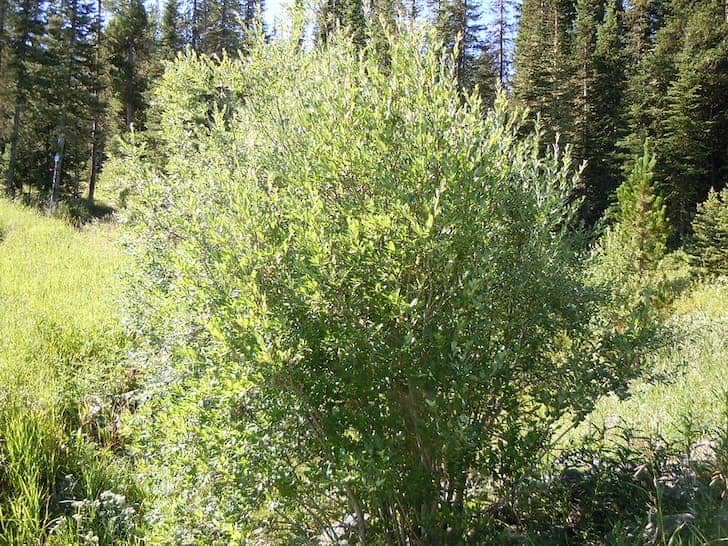
The Bebb willow is also known as the Beak willow or the Salix bebbianca. It belongs to the family of Salicaceae with no known hazards and growth of around 23ft.
It’s a shrub most suitable for any soil involving light sandy soil, loamy, or even heavy clay-like soils. However, this particular shrub can not grow in the shade and requires moist or wet soil to grow properly.
Primarily found in North America, this tree also serves several medicinal purposes, like applying the inner part of the bark on a deep cup or using it as a sanitary napkin in times of need.
4. Yellow Willow (Salix lutea)
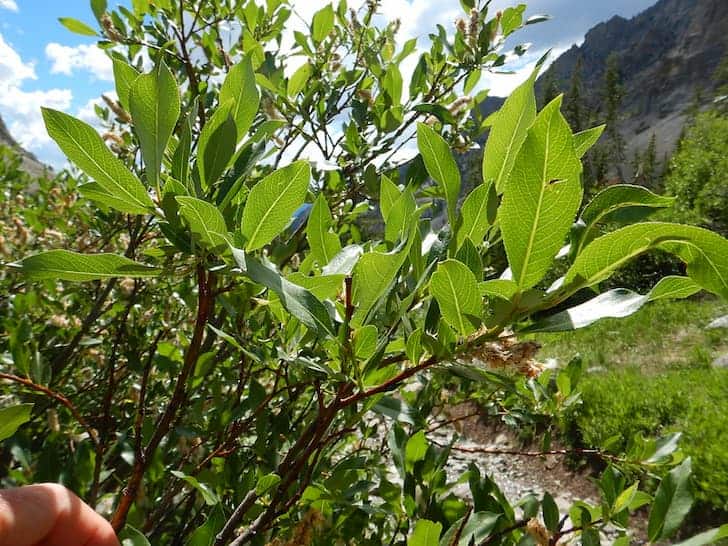
This kind of willow would attract you not just for its beauty but also for its uniqueness. On average, the yellow willow is around 16-23 ft tall and has an upright form supporting various wildlife, including birds, butterflies, and moths.
It’s known as the Salix Lutea scientifically and is found in parts of California. This tree is used chiefly for gardens and is adaptable and tolerant to sand, clay, and loam.
These are also regularly cut down so that their growth continues in a less messy but bushy habit, making their color and stems much more prominent.
5. Corkscrew Willow (Salix matsudana)
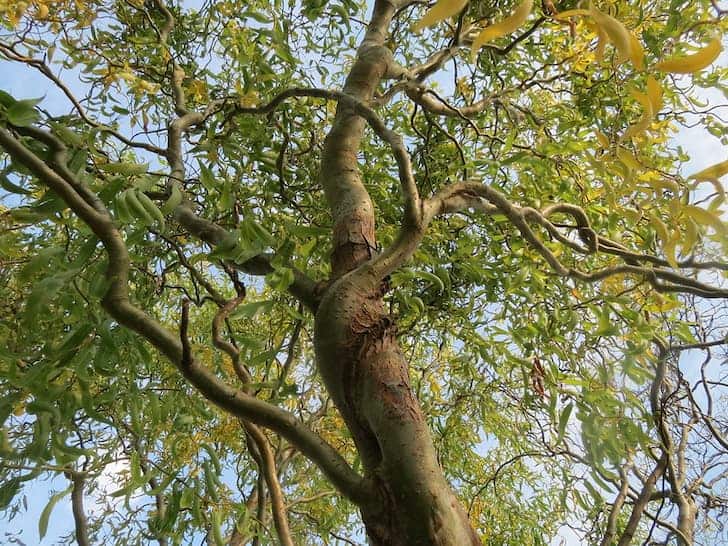
You must be curious why this particular tree has such a unique name, right? This willow tree is called a corkscrew because of its peculiar branches are twisted and curled, bearing similar curly leaves. This causes the Salix matsudana, another name for this willow tree, to be an attraction in your gardens or yards.
It’s known to be a fast-growing tree with a spread of 20 feet or more, while its leaves turn a beautiful yellow in the fall. Each leaf grows to be about 3-5 inches in length with around .5 inches in width.
This tree also has medicinal uses; its twigs can be used in traditional medicines to treat pain and fevers. That is because the corkscrew willow contains salicylic acid and is beneficial for health.
6. White Willow (Salix alba)
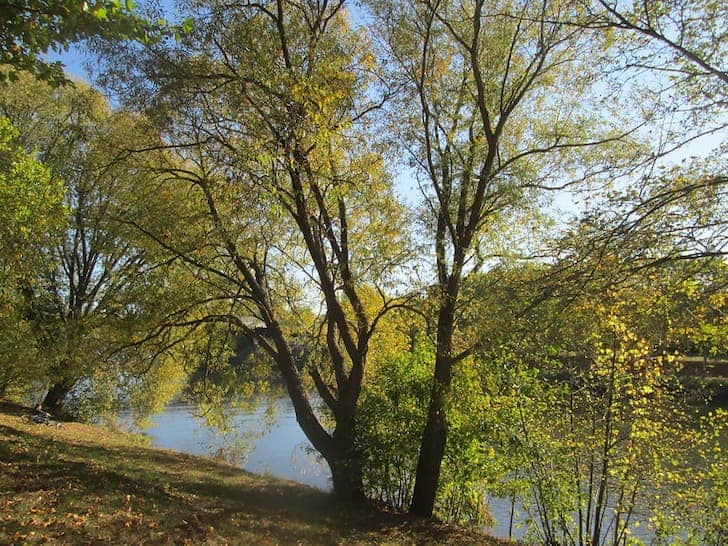
Just like the name suggests, the white willow is known for the silvery appearance of its leaves that makes you want to stop and stare. The white willow is, also known as the Salix Alba, found alongside river coasts, reaching its full height in around 20 years.
The white willow is classified as an invasive plant by the US Forest Service, contributing to the decline of endangered species around it. However, they’re considered to be generally safe trees, with their bark having incredible health uses. Still, just like anything taken in an overdose, too much of it can cause side effects like irritation and increased blood pressure.
7. Narrowleaf Willow (Salix exigua)
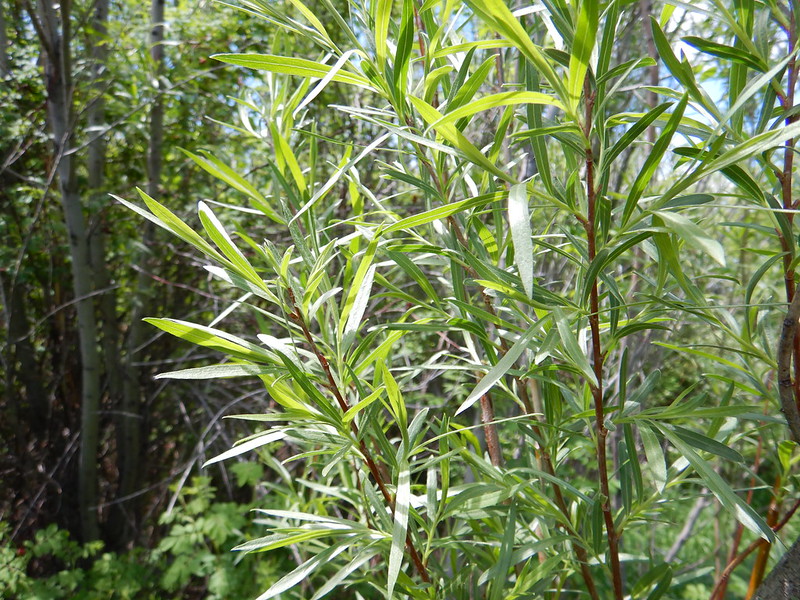
Narrowleaf willow, also known as the coyote willow or the sandbar willow, blooms in a beautiful white and yellow color, mainly during March and April.
This particular shrug grows out to be around 12 to 36 ft and is spotted amongst ditches and sandbars that dig deep to be about 3000ft.
In case you do come across one, the perfect way to identify them is to peek at its leaves. You might have an idea from its name, but the Narrowleaf Willow has flat linear leaves covering its branches, with flowers looking like fluffy green spikes.
8. Dappled Willow (Salix integra)
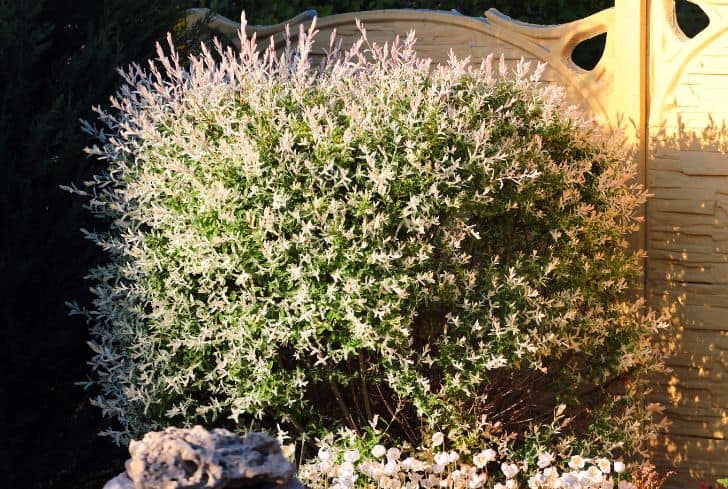
If you do manage to come across a dappled willow, there is a possibility that you will confuse it with a tree. However, this plant comes from the house of shrubs, thriving in the winter and cool conditions.
Easily maintained at a smaller scale, this shrub brings hues of pink and green into your garden, with its leaves turning a nice red color in the fall and turning brownish yellow in winter.
Just like any other willow tree, the dappled willow also has invasive roots that spread and multiply. Hence, the best way to plant these is to ensure that each of the shrubs is at least six feet apart from the other.
However, if you want to plant them closer to each other, you have to ensure that they’re trimmed regularly and that you’re okay with the stems growing into each other.
9. Scouler’s Willow (Salix scouleriana)
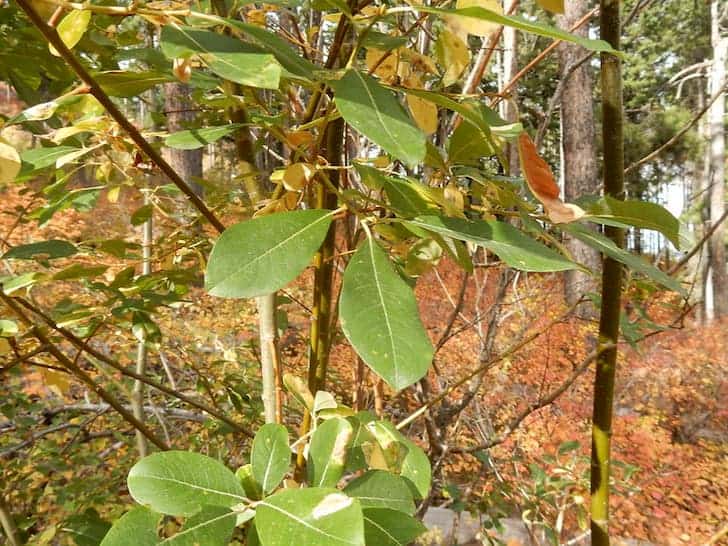
Scouler’s willow is also known as Salix Scouleriana. It belongs to the species of willows falling native to North America.
Just like they take the form of shrubs, this willow can also take the form of a small tree with a bark that’s thin but has broad, straight, and firm branches. The tree grows to about 6.6-50 ft tall with an upright form.
Along with its incredible height, the tree also tends to be deciduous in winter, with flowers blooming in winter and spring. Those flowers are usually seen in yellow, cream, and white colors. Their beauty is something that everyone should consider having in their landscape if they have the space for it.
10. Crack Willow (Salix fragilis)

The salix fragilis, or the crack willow, has been given this name due to the noisy and loud cracks that wrap its branches. Native to riparian habitats, the crack willow is mainly seen in Europe and East Asia.
Having small but rapid growth, this species of willow goes to live for over 100 years. Although unfortunately, they do tend to crack and split due to their weight.
Like other members of its species, the Salix Fragilis can also be used for weaving. It tends to be an invasive species alongside watercourses, which can cause social, environmental, and severe economic impacts.
11. Goat Willow (Salix caprea)
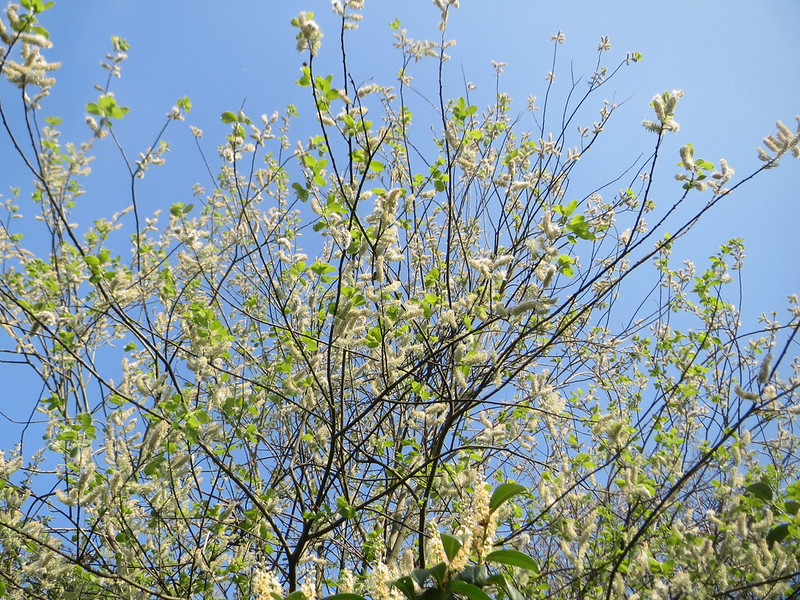
Mostly uncommon, goat trees are known to be found in the Caledonian Forest, covering a significantly large landscape.
They’re known for their fluffy and grey male catkins that turn yellow in March and slightly resemble a cat’s paw. You might mostly find these trees in ditches, redbeds, and on urban ground waste.
Unlike most plants that cover the coats of waterbeds, the goat willow, also known as the pussy willow, stops the flow of water and reduces aeration. Unfortunately, this causes the water to take another path and ends up flooding the creek banks.
12. Peach-leaf Willow (Salix amygdaloides)
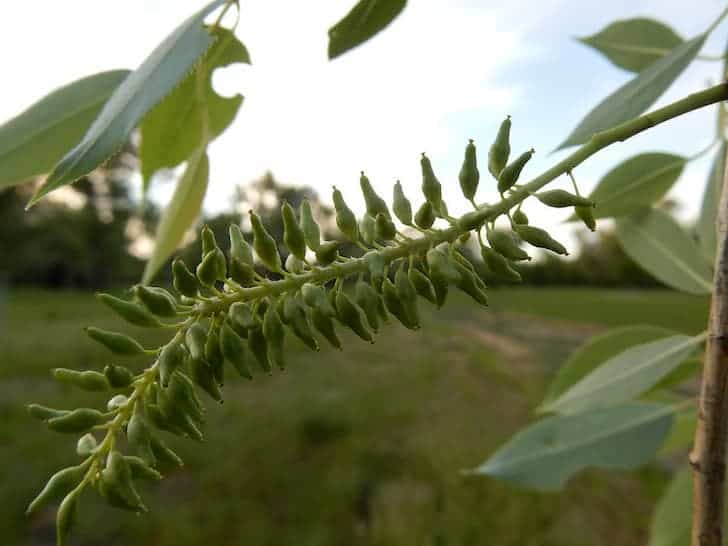
The peach-leaf willows are said to be the most common among the willows in the salix species. They bloom the best in May and June, and their ideal habitat involves sunny weather with moist or wet surfaces, commonly by the river shores, hence allowing the leaves and the flowers of this tree to grow healthily and steadily.
Even though most willows have a similar structure to their leaves, with little differences, the peach-leaf willow tends to have leaves covered by crinkly hair on the surface. They also tend to have fruit spikes growing on them that are more loosely arranged than the flowers.
The peach-leaf willow grows to be 13 to 65 ft with trunks that can either be single or in a bunch. Each trunk can be measured to be around 30 inches.
Read: 15 Fastest Growing Trees in the World (+Pics)
13. Almond Willow (Salix triandra)
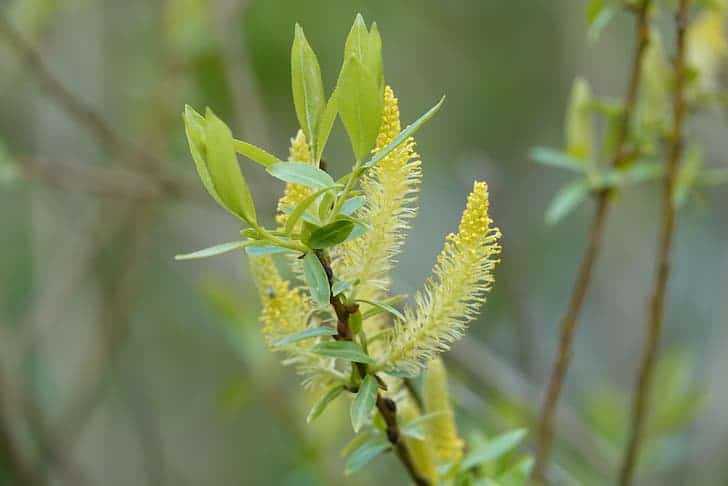
The almond willow belongs to the family of Salicaceae, with its Latin name being Salix Triandra. It is mainly found from April to May, although less common in the North and Southwest.
Usually, the almond willow tends to grow in wet ditch banks or someplace that’s considered marshy. It’s a small shrub that grows out to be around 10 meters and has male catkins appearing on its leaves.
Another thing to notice about this particular tree is that its bark tends to shed and fall in patches, which exposes a reddish-brown color underneath. Although tough to identify, the almond willow consists of leaves that are regularly edged.
To sum up, this article touches on the thirteen different types of Willow trees and shows you the differences as well as similarities between them. Overall, you can come across many different types of willow trees.
Some are similar, while some are incredibly different but equally beautiful. Hopefully, this blog had adequate information to help you recognize which willow tree you’ve come across if you ever do.






